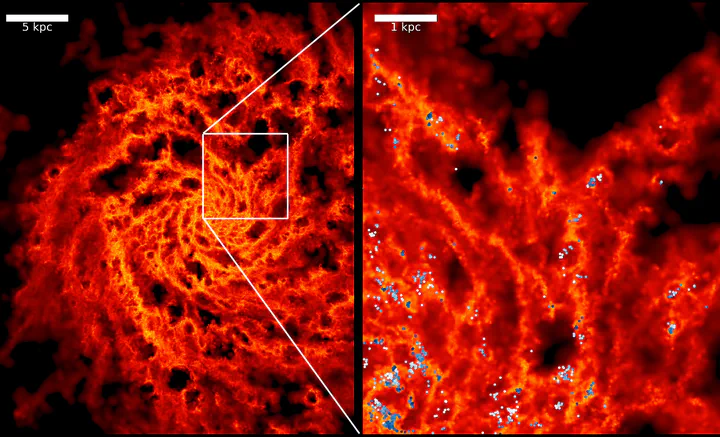Stellar feedback and Giant Molecular Cloud Evolution

Stars form in messy and chaotic environments within Giant Molecular Clouds (GMCs). These GMCs are very interesting objects because of the rich physical processes that describe their evolution – GMCs are magnetized, supersonically turbulent fluids which are altered by feedback from newly formed stars. Young stars produce energetic outflows, winds and carve bubbles of hot ionized gas. The most massive stars end their lives by going supernova, while new stars are still forming. All these physical processes feed gas back into the parent GMC and disrupt them.
In Khullar et al (2024), we explore the role of stellar feedback in the evolution of Giant Molecular Clouds. We conducted a feedback-halting experiment starting with a Milky Way-mass galaxy in the FIRE-2 simulation framework. Terminating feedback, and comparing to a simulation in which feedback is maintained, we monitor how the runs diverge. We find that stellar feedback is the dominant contributor to the turbulent energy budget at the ~ 0.5 kpc scale. There is a marked increase of dense material, while the SFR increases by over an order of magnitude. Importantly, this SFR boost is a factor of ∼15-20 larger than is accounted for by the increased free fall rate caused by higher densities. This implies that feedback moderates the star formation efficiency per free-fall time more directly than simply through the density distribution. To probe changes at the scale of giant molecular clouds (GMCs), we identify GMCs using density and virial parameter thresholds, tracking clouds as the galaxy evolves. Halting feedback stimulates rapid changes, including a proliferation of new bound clouds, a decrease of turbulent support in loosely-bound clouds, an overall increase in cloud densities, and a surge of internal star formation. Computing the cloud-integrated SFR using several theories of turbulence regulation, we show that these theories underpredict the surge in SFR by at least a factor of three. We conclude that galactic star formation is essentially feedback-regulated on scales that include GMCs, and that stellar feedback affects GMCs in multiple ways.